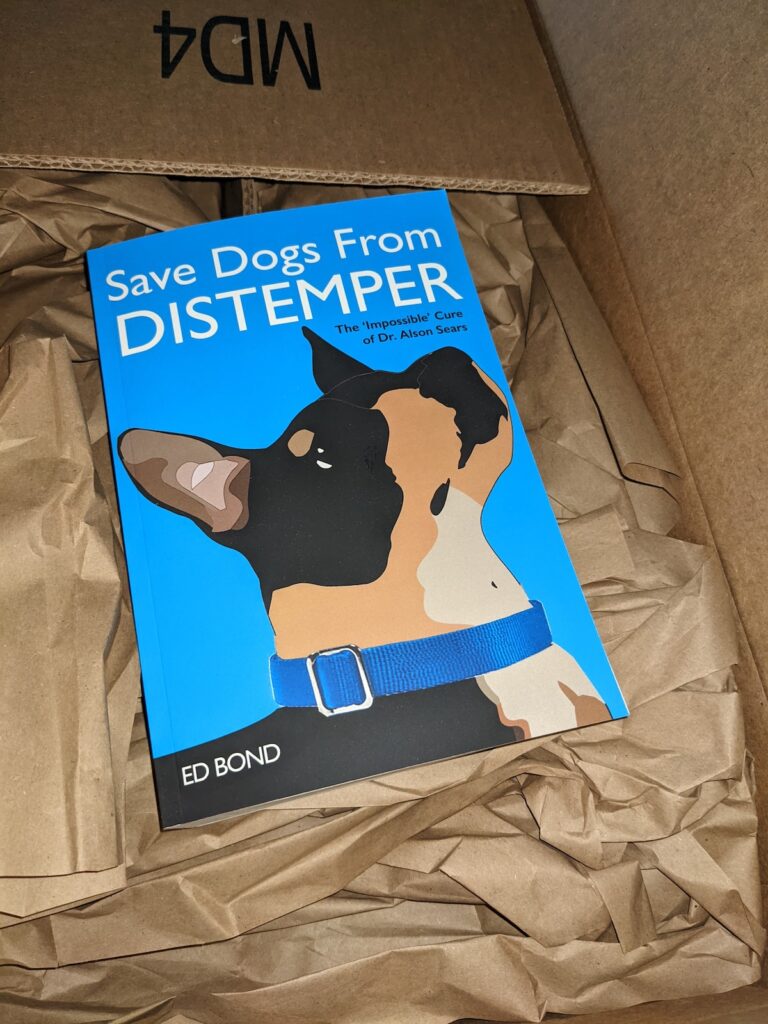The recent article in Time magazine by Naomi Osaka: ‘It’s O.K. Not to Be O.K.’ was a welcome reminder that we all need to take care of our mental health. It’s an issue I needed to deal with in writing my book, and I’d wager it is something that everyone who fights to save a distemper dog must be aware of. We all need to take care of ourselves even when trying to help others.

In the spirit of sharing and lifting the stigmas of mental health, I’m sharing some of the excerpts from the book “Save Dogs From Distemper: The ‘Impossible’ Cure of Dr. Alson Sears.” These are struggles we all have.
[The first excerpt is from spring of 2013 …]
“For me, the daunting problems also fueled another issue I had been grappling with. At this point, I walked with cane and
my foot in either a cast or a special boot. I had not regularly
exercised since the injury in January 2012. Looking back at
spring of 2013, I’ve come to realize I also had an undiagnosed
injury: clinical depression.
“This book is supposed to be about canine distemper, but
the depression does play a small role in the story. Since I believe
that stigmas about mental health issues need to be dispelled, I’ll
try to talk about it briefly and without being … depressing.
“Compared with many others, my experience with depression created only a temporary setback. My case is more
like receiving a sharp injury that took a while to recover. More
like that injury to my foot in the marathon.
That foot injury had plagued me for years. By continually
using my foot, the tendon could not recover. The point of the
surgery was to repair the damage so that the foot could heal
and get stronger. The mental injury also needed to be repaired
so recovery could happen.
“The mental injury happened in the spring of 2010 when
both my journalism and teaching careers had ended. In my
brain, I had shrugged at this turn of events. ‘I’ll find something
else.’ After all, this was possibly a chance to pursue my fiction
writing. I was also glad to have the time to devote to a cause I
cared about.
“But even though my brain shrugged, my emotions had
their own reaction. Letting go of both of those careers had been
a big blow to my identity. For 25 years, I had either been a
journalist or a journalism teacher.
“Simply put, I was sad. This did not surprise me. No big
deal. People have sad things happen to them all the time, and
much worse than what I had. For example, Amy lost her dad
and her sister within six months. So, my career setbacks do not
come close to what she went through. However, a counselor
later explained to me that after about two years, the sadness I
still felt could change the chemistry in my brain. This makes it
difficult to attempt tasks.
“For anyone who just says depression is “all in your
head,” they are right. It is. But that doesn’t mean it is not real or
that you can just “get over it.” Back in the 1980s, Rodney
Dangerfield had a bit in his comedy routine where he talked
about “The Heaviness.” He would say, “The heaviness is
always there.” Now, I understand what he was talking about.
Tasks and goals now came with an extra weight. I could feel
them grow heavier as I approached them, as if slogging through
a tar pit. Anxiety and self-esteem problems also go along with
depression. It took great effort to make phone calls, and
receiving phone calls from people I didn’t know or expect sent
me into a tail-spin.
“Makes it difficult to be an advocate for a cause. I had fallen a long way from what I had been at the L.A. Times.
“As I write this, my feet are stronger than they had ever
been. I can walk barefoot without pain. I can run or walk for an
hour or more. I just played a game of badminton on my brother-in-law’s front lawn IN MY BARE FEET! And just as my feet
could be fixed, so could my brain. The damage to my brain
chemistry has been adjusted, and the heaviness has gone away.
But diagnosis always comes first, and in spring of 2013,
diagnosis remained more than two years away.”
[This next passage is from fall of 2014, when my buddy Jeff visited and I realized I had depression.]
“By the end of his visit, I realized I was happy. From that, I finally understood I’d been depressed for a long time, probably since the end of my journalism and teaching careers. To be honest, the thousands of emails I’d received about canine distemper also deepened the depression. More dogs were saved than lost, but many were lost. In the past five years or so, I’d received photos and videos of sick, dying and dead dogs from all over the world.
“Even though I always explained up front to people that I
am not a vet or a doctor and could not possibly diagnose their
dogs for them [something that cannot happen over email] I still
got copies of lab reports and close-up photos of dry paw pads,
dry eyes, poop, diarrhea and rashes. Sometimes owners would
send me videos of operations, dogs in seizures, dogs spasming,
shaking and scared. Photos of dead dogs on blankets, pillows
and next to shallow graves landed in my Inbox.
“These owners needed to send these videos and photos
because they were scared or grieving. They needed to express
what they were going through and know that someone else
understood without judging or blaming them. When our puppy
Selkie died back in 1996, the vet who euthanized her
admonished us afterwards, saying that we should make sure to
get our next puppy vaccinated. That still pisses off Amy, the
assumption being we had done something wrong to kill our
puppy. We’d taken Selkie to our vet immediately for a checkup
and vaccinations after adoption, but she had already been
exposed.
“When a dog gets distemper that is not the time to
admonish the owner. A distemper case does not always mean
vaccination was neglected. The veterinarian and staff should
remember that vaccinations do not always work, especially if
the dog is somehow immune compromised. They should at
least ask about the dog’s vaccination history before leaping to a
conclusion.
“For whatever reason the dog got infected, it happened.
It’s a fact that must now be handled. Do what you can to protect
other dogs from infection. Most importantly, what you do have
is a patient sick with a disease. What can be done now? The best
time for the vaccination lesson is before (or at least when) the
dog is adopted. If it is clear the owner of a distemper dog did
miss the lesson on vaccination, you might find a compassionate
way to let them know before they get away. But while I have
your attention right now: Always get your dogs vaccinated!
“When someone writes to tell me their dog died, I
sometimes tell them I still remember what it was like to have
puppies die of distemper. Sometimes I skip that part because
not everyone feels the loss the same way. So, it’s arrogant to
assume you know what they are going through, how long the
pain will last or whether a new pet will make things better. In
my replies to these emails, I usually say some variation of ‘I’m
so sorry for your loss. Distemper is a nasty disease that does not
play fair. It is a terrible way to lose a good friend and family
member. My hope for you is a future with happy, healthy
dogs.’
“When I write these condolences, I remind myself of the
joy of the dogs who have lived and the hope that someday
perhaps dogs will no longer have to die of this disease. That’s
what kept me going.
“The other weight that added to the depression was the
unremitting silence. The unanswered phone calls and emails.
The vets and scientists who refuse to even consider that
distemper is a problem worth solving or that a solution is
possible. I am aware of the dismissive criticisms online. I have
no standing within the veterinary or scientific community, so I
understand. Were I in your position I might say the same. But
the universe gave me a choice: Do nothing and dogs would
certainly die. Do something and perhaps some could be saved.
Do something, and maybe canine distemper would stop being
such a deadly disease.
“So in December 2008, I chose to do something. I chose to
try. I made that choice because I don’t like dogs dying when
they don’t have to.
“Recognizing the depression broke the hold it had over
me. I quickly realized the anxiety and self-esteem issues that
came with it and began to deal with those. When I felt dread as
I approached a task, I recognized what was going on and fought
to overcome it. In the next few months, I gradually got better
but I would eventually decide I did not have the power to
completely defeat the depression on my own. I’d need a little
help.
[This passage is from a year later when I finally went to get help.]
“A blog post on another website changed my life for the
better. Wil Wheaton, who played Wesley Crusher on “Star Trek:
The Next Generation,” had posted a video online describing a
panic attack he’d had at an airport. In that moment, his wife
helped him realize he had a mental health issue. In his video, he
explained how those with depression, anxiety and other issues
could get help.
He helped me realize that although I had come a long way to climb out of the depression, I couldn’t quite get all the way out of the hole without a little help. So, I went to counseling. The counselor had me get a prescription from my doctor. With the medication, counseling, much longer walks with Romeo at night and the music of Brandi Carlile, I began to climb out of the hole. Brandi taught me to feel joy despite the regrets of the past and to not let others tear me down.”
Today I believe I have overcome the bout with depression. I have learned to believe in myself because others believe in me. As Naomi Osaka says, you can’t please everyone. I have learned to see the truth and value of those who would criticize me. I try to learn and grow from that point of view, but without letting it tear me down.
— Ed Bond
Here’s a PDF of the pages I quoted from the book:
